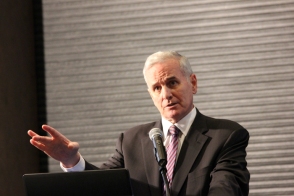Management will be meeting with our negotiating team for one more round of talks today from 2 – 6 p.m. at the DCU Center in the Shark Tank Room, where we …
UMass University Nurses Strike Update: Contract Talks Scheduled Today At DCU Shark Tank from 2 – 6 p.m.
Pre-Strike Rally at Coral Seafood at 6
Management will be meeting with our negotiating team for one more round of talks today from 2 – 6 p.m. at…
NINR Welcomes Five New Members to the National Advisory Council for Nursing Research
UMass Univversity Nurses Strike Handbook
UMass University Nurses
Strike Handbook
GENERAL INFORMA…
Governor and legislative leaders rebalance the budget
The hand-wringing and the vote-counting are over.
Minnesota finally has a budget that protects the middle class, invests in our future, and protects the health of seniors.
It was no mean feat. The Governor and the legislative leaders had to hold fast to the right priorities through threats of filibusters, add-on amendments, and even talk of businesses exiting the state.
Governor Mark Dayton and legislative leadership had to rectify years of imbalanced budgets and re-invest in state programs that had been long ignored. In summary, the top 2 percent of wage earners will pay about 2 percent more in taxes, which will raise $1 billion dollars; cigarette and other tobacco taxes go up, which will raise another $600 million and hopefully convince some to quit; and they found money in the couch cushions too by closing corporate tax loopholes, which raises $424 million in business tax write-offs.
Doing all that meant the Governor could sign an $11.2 billion health and human services budget bill, which includes a 5 percent rate increase for nursing homes next year-much of that goes to workers who care for our seniors-along with another 3.2 percent increase by 2016. While some proposals saw health and human services losing $150 million, this investment ensures seniors will receive good quality care and their care-givers will be better paid for their priceless work. That keeps experienced nurses and care-givers protecting our seniors. Nurses at state facilities will also see a 2 percent raise retroactive to this year.
Legislative leaders needed to re-right the boat after eight years of no new taxes has denied Minnesota the ability to move forward and placed the middle-class in a squeeze from all their other taxes going up, including local property taxes, school levies, and other referenda. With a stable base of revenue coming into the state, Minnesotans should be able to count on their health, their children, and their seniors continuing to be cared for without worrying what the next year will bring.
Concerns About Poor Patient Care Conditions Forces UMass Medical Center Nurses To Conduct One-Day Strike on Thursday, May 23
Management Walked Out of Talks on Tuesday, Refusing to Address Nurses’ Staffing Concerns Threatens to Impose Four-Day Lockout After the Strike, Subjecting…
More Men Are Being Educated as Registered Nurses
UMMMC University Nurses Contract Alert! Talks Today Result in No Settlement After Management Walks Out Refuses to Respond
Our One-Day Strike is On For May 23
Talks today failed to result in a settlement of a contract for the University campus nurses, when management walked out of …
MNA NewsScan, May 20, 2013: MN health care innovation cuts costs for the poor; poverty up in the suburbs
HEALTH CARE
Is the Future of American Health Care in Oregon? “The governor has a notion that you can move away from medical billing and towards a more flexible approach to health-care spending that makes more sense for the community,” John McConnell, a health economist at Oregon Health and Science University, is telling me. Then he stops. “You’ve heard the air conditioner story, right?”
Medicaid Opposition Underscores States’ Health Care Disparities Republican opposition in many statehouses to expanding Medicaid next year under President Obama‘s healthcare law — opposition that could leave millions of the nation’s poorest residents without insurance coverage — will likely widen the divide between the nation’s healthiest and sickest states.
Minnesota Health Care Program Cuts Costs for the Poor Many other states are simply cutting medical assistance funds or moving patients into private managed-care health plans in hopes of saving money. But Minnesota is exploring new options like Hennepin Health in which the state contracts directly with county or medical providers who have banded together to provide care for a certain number of patients — giving them greater control of medical assistance dollars and, in turn, more freedom to innovate and focus on preventive care.
LABOR UPDATES
Twin Cities’ Rise in Suburban Poverty Among Highest in Nation The Brookings Institution on Monday will release a study ranking the Twin Cities area among the nation’s top 10 major metropolitan areas for the speed at which suburban poverty is rising. Its analysis says the number of suburban Minnesotans living in poverty more than doubled between 2000 and 2011.
